Page 130 of 356
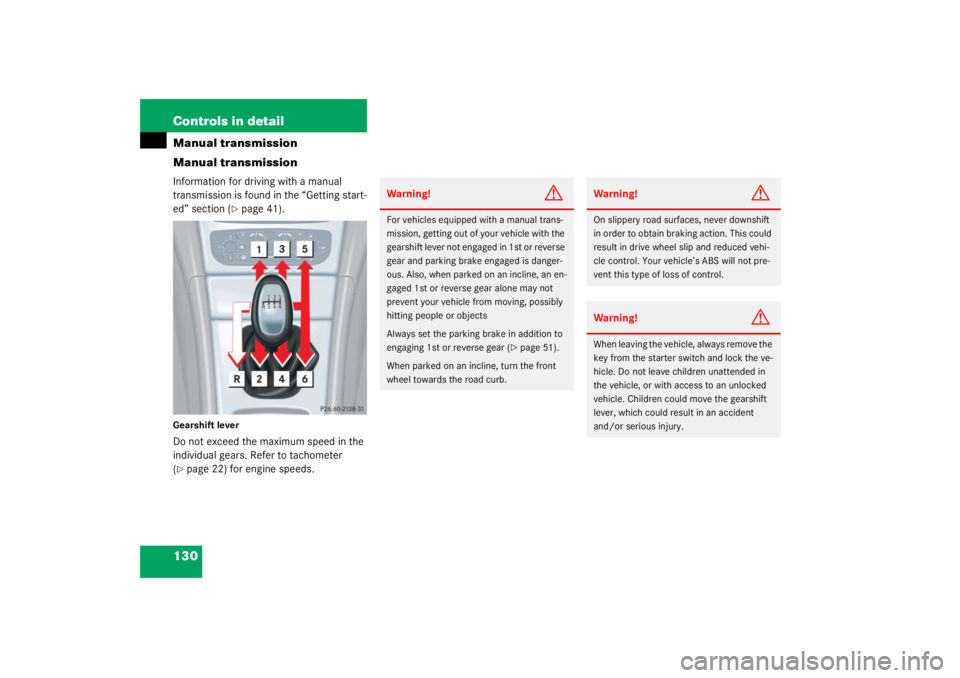
130 Controls in detailManual transmission
Manual transmissionInformation for driving with a manual
transmission is found in the “Getting start-
ed” section (
�page 41).
Gearshift leverDo not exceed the maximum speed in the
individual gears. Refer to tachometer
(�page 22) for engine speeds.
Warning!
G
For vehicles equipped with a manual trans-
mission, getting out of your vehicle with the
gearshift lever not engaged in 1st or reverse
gear and parking brake engaged is danger-
ous. Also, when parked on an incline, an en-
gaged 1st or reverse gear alone may not
prevent your vehicle from moving, possibly
hitting people or objects
Always set the parking brake in addition to
engaging 1st or reverse gear (
�page 51).
When parked on an incline, turn the front
wheel towards the road curb.
Warning!
G
On slippery road surfaces, never downshift
in order to obtain braking action. This could
result in drive wheel slip and reduced vehi-
cle control. Your vehicle’s ABS will not pre-
vent this type of loss of control.Warning!
G
When leaving the vehicle, always remove the
key from the starter switch and lock the ve-
hicle. Do not leave children unattended in
the vehicle, or with access to an unlocked
vehicle. Children could move the gearshift
lever, which could result in an accident
and/or serious injury.
Page 131 of 356
131
Controls in detail
Manual transmission
Shifting into reverse�
Stop the vehicle completely.
�
Pull gearshift lever up and shift in
R
reverse.
!Downshifting gears leading to overrev-
ving the engine can result in engine
damage that is not covered by the
Mercedes-Benz Limited Warranty.
Do not exceed the engine speed limits
(�page 310).
Never hold the vehicle stopped on a hill
by using the clutch pedal. The clutch
may be damaged which is not covered
by the Mercedes-Benz Limited Warran-
ty.
Page 132 of 356
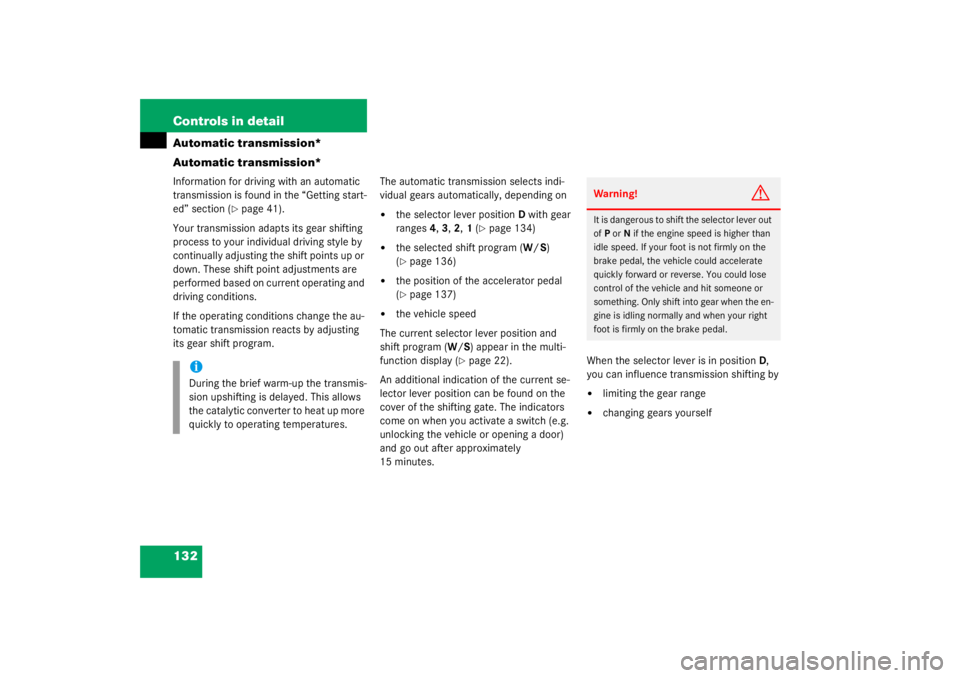
132 Controls in detailAutomatic transmission*
Automatic transmission*Information for driving with an automatic
transmission is found in the “Getting start-
ed” section (
�page 41).
Your transmission adapts its gear shifting
process to your individual driving style by
continually adjusting the shift points up or
down. These shift point adjustments are
performed based on current operating and
driving conditions.
If the operating conditions change the au-
tomatic transmission reacts by adjusting
its gear shift program. The automatic transmission selects indi-
vidual gears automatically, depending on
�
the selector lever position
D with gear
ranges 4, 3 , 2 , 1 (
�page 134)
�
the selected shift program ( W/S)
(�page 136)
�
the position of the accelerator pedal
(�page 137)
�
the vehicle speed
The current selector lever position and
shift program ( W/S) appear in the multi-
function display (
�page 22).
An additional indication of the current se-
lector lever position can be found on the
cover of the shifting gate. The indicators
come on when you activate a switch (e.g.
unlocking the vehicle or opening a door)
and go out after approximately
15 minutes. When the selector lever is in position
D,
you can influence transmission shifting by
�
limiting the gear range
�
changing gears yourself
iDuring the brief warm-up the transmis-
sion upshifting is delayed. This allows
the catalytic converter to heat up more
quickly to operating temperatures.
Warning!
G
It is dangerous to shift the selector lever out
of P or N if the engine speed is higher than
idle speed. If your foot is not firmly on the
brake pedal, the vehicle could accelerate
quickly forward or reverse. You could lose
control of the vehicle and hit someone or
something. Only shift into gear when the en-
gine is idling normally and when your right
foot is firmly on the brake pedal.
Page 133 of 356
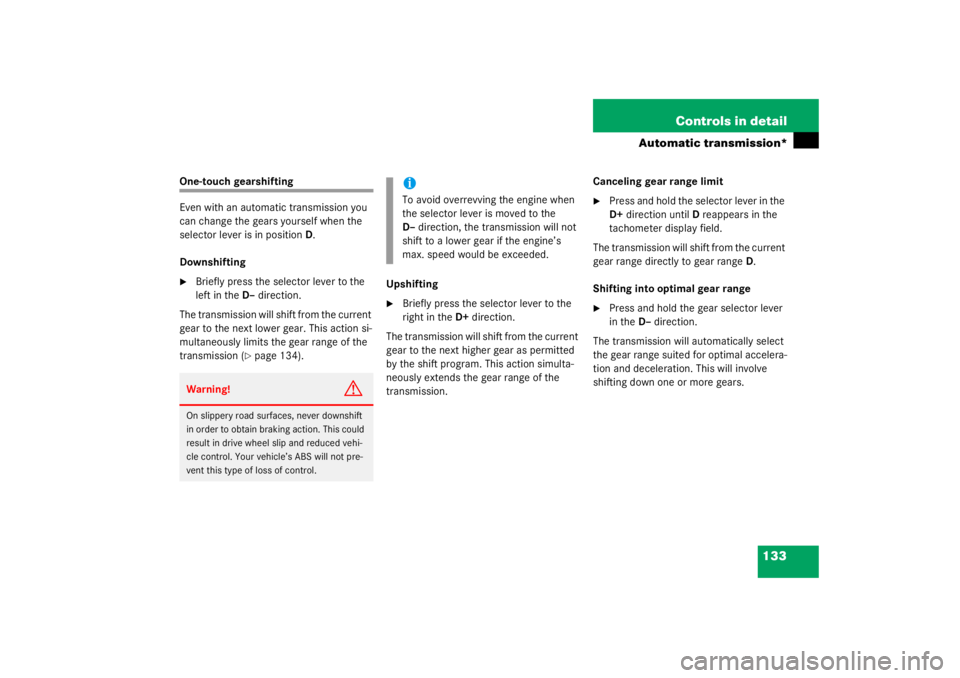
133
Controls in detail
Automatic transmission*
One-touch gearshifting
Even with an automatic transmission you
can change the gears yourself when the
selector lever is in position
D.
Downshifting�
Briefly press the selector lever to the
left in the D–direction.
The transmission will shift from the current
gear to the next lower gear. This action si-
multaneously limits the gear range of the
transmission (
�page 134). Upshifting
�
Briefly press the selector lever to the
right in the
D+direction.
The transmission will shift from the current
gear to the next higher gear as permitted
by the shift program. This action simulta-
neously extends the gear range of the
transmission. Canceling gear range limit
�
Press and hold the selector lever in the
D+
direction until D reappears in the
tachometer display field.
The transmission will shift from the current
gear range directly to gear range D.
Shifting into optimal gear range
�
Press and hold the gear selector lever
in the D– direction.
The transmission will automatically select
the gear range suited for optimal accelera-
tion and deceleration. This will involve
shifting down one or more gears.
Warning!
G
On slippery road surfaces, never downshift
in order to obtain braking action. This could
result in drive wheel slip and reduced vehi-
cle control. Your vehicle’s ABS will not pre-
vent this type of loss of control.
iTo avoid overrevving the engine when
the selector lever is moved to the
D– direction, the transmission will not
shift to a lower gear if the engine’s
max. speed would be exceeded.
Page 134 of 356
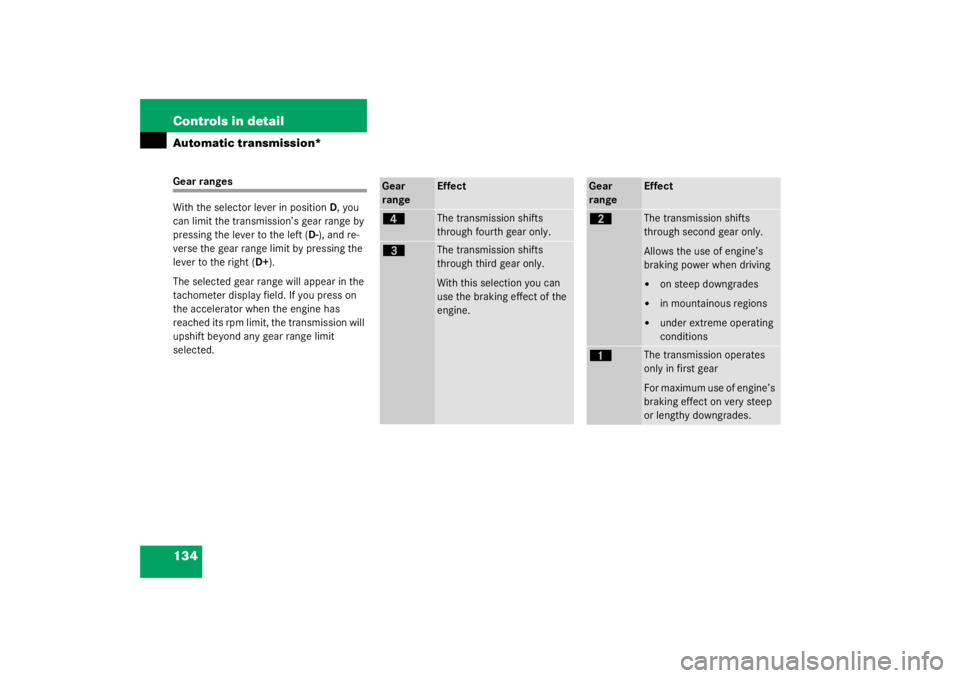
134 Controls in detailAutomatic transmission*Gear ranges
With the selector lever in positionD, you
can limit the transmission’s gear range by
pressing the lever to the left ( D-), and re-
verse the gear range limit by pressing the
lever to the right ( D+).
The selected gear range will appear in the
tachometer display field. If you press on
the accelerator when the engine has
reached its rpm limit, the transmission will
upshift beyond any gear range limit
selected.
Gear
range
Effect
é
The transmission shifts
through fourth gear only.
è
The transmission shifts
through third gear only.
With this selection you can
use the braking effect of the
engine.
Gear
range
Effect
ç
The transmission shifts
through second gear only.
Allows the use of engine’s
braking power when driving �
on steep downgrades
�
in mountainous regions
�
under extreme operating
conditions
æ
The transmission operates
only in first gear
For maximum use of engine’s
braking effect on very steep
or lengthy downgrades.
Page 136 of 356
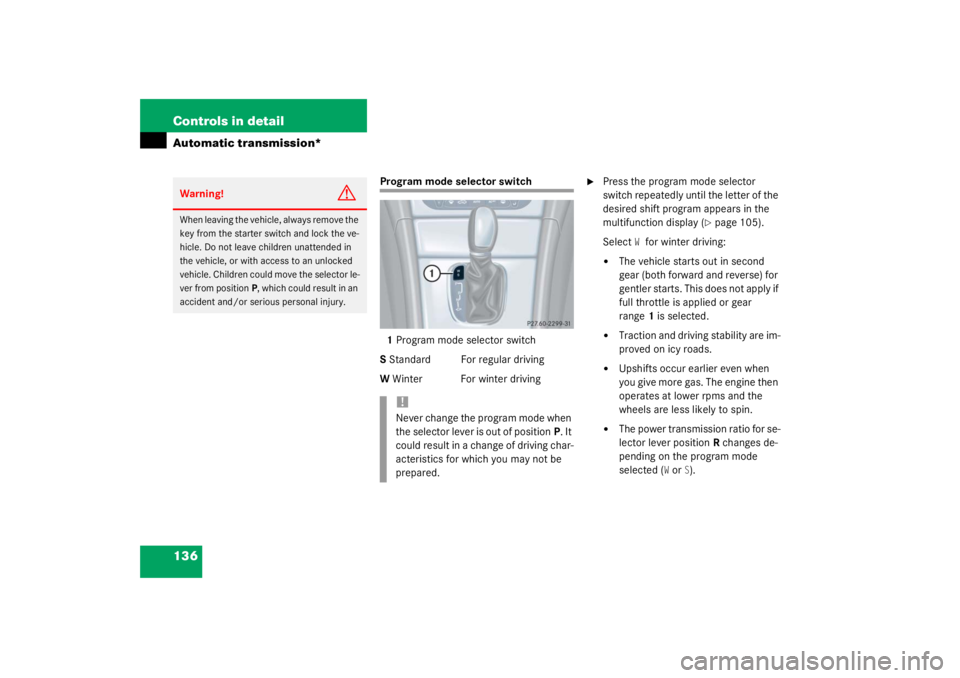
136 Controls in detailAutomatic transmission*
Program mode selector switch1 Program mode selector switch
S Standard For regular driving
W Winter For winter driving
�
Press the program mode selector
switch repeatedly until the letter of the
desired shift program appears in the
multifunction display (
�page 105).
Select
Wfor winter driving:
�
The vehicle starts out in second
gear (both forward and reverse) for
gentler starts. This does not apply if
full throttle is applied or gear
range 1 is selected.
�
Traction and driving stability are im-
proved on icy roads.
�
Upshifts occur earlier even when
you give more gas. The engine then
operates at lower rpms and the
wheels are less likely to spin.
�
The power transmission ratio for se-
lector lever position R changes de-
pending on the program mode
selected (
W or
S).
Warning!
G
When leaving the vehicle, always remove the
key from the starter switch and lock the ve-
hicle. Do not leave children unattended in
the vehicle, or with access to an unlocked
vehicle. Children could move the selector le-
ver from position P, which could result in an
accident and/or serious personal injury.
!Never change the program mode when
the selector lever is out of position P. It
could result in a change of driving char-
acteristics for which you may not be
prepared.
Page 137 of 356

137
Controls in detail
Automatic transmission*
Accelerator position
Your driving style influences the transmis-
sion’s shifting behavior:
Less throttle Earlier upshifting
More throttle Later upshifting
Kickdown
Use kickdown when you want maximum
acceleration.�
Press the accelerator past the point of
resistance.
The transmission shifts into a lower
gear.
�
Ease on the accelera
tor when you have
reached the desired speed.
The transmission shifts up again. Emergency operation (Limp Home
Mode)
If vehicle acceleration worsens or the
transmission no longer shifts, the trans-
mission is most likely operating in limp
h o m e ( e m e r g e n c y o p e r a t i o n ) m o d e . I n t h i s
mode only 2nd gear and reverse gear can
be activated.�
Stop the vehicle.
�
Move selector lever to
P.
�
Turn off the engine.
�
Wait at least ten seconds before re-
starting.
�
Restart the engine.
�
Move selector lever to position D (for
2nd gear) or R.
�
Have the transmission checked at an
authorized Mercedes-Benz Center as
soon as possible.
Page 144 of 356
144 Controls in detailClimate controlThe climate control is operational whenev-
er the engine is running. You can operate
the climate control system in either the au-
tomatic or manual mode. The system cools
or heats the interior depending on the se-
lected interior temperature and the cur-
rent outside temperature.
Nearly all dust particles, pollutants and
odors are filtered out before outside air en-
ters the passenger compartment through
the air distribution system.The air conditioning will not engage (no
cooling) if the
AC
OFF
mode is selected
(
�page 148)Warning!
G
Follow the recommended settings for heat-
ing and cooling given on the following pag-
es. Otherwise the windows could fog up,
impairing visibility and endangering you and
others.
iIf the vehicle interior is hot, ventilate
the interior before driving off.
Keep the air intake grille in front of the
windshield free of snow and debris.